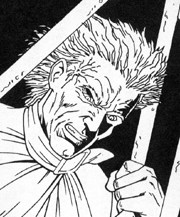The lineage known as House Palpatine, alternatively referred to as the Imperial family, represented a distinguished noble human bloodline. Originating from the planet Naboo, situated within the Mid Rim region of the galaxy, this family ascended to become the governing power of the Galactic Empire. Throughout its history on Naboo, House Palpatine maintained a reputation for its conservative and isolationist principles, although its influence and wealth were not as significant as those of other Royal Houses on Naboo.
Around 65 BBY, the existence of House Palpatine faced near annihilation when Cosinga Palpatine's oldest son, who preferred to be known simply as Palpatine, committed patricide and fratricide, wiping out his entire immediate family, including his own father. After his family's demise, Palpatine was inducted into the Order of the Sith Lords by Darth Plagueis, assuming the identity of Darth Sidious. Subsequently, he seized control of the galaxy, ruling as Emperor of the Galactic Empire for over two decades. During his reign, numerous individuals asserted claims of familial connection to House Palpatine. Similarly, after the Emperor's downfall, pretenders emerged, seeking to legitimize their claims to the throne. The family's emblematic color was scarlet, prominently displayed on their family crest, which depicted a veermok, an aiwha, and a zalaaca.
According to the words of Cosinga, House Palpatine was one of the six unyielding barriers that restrained chaos in Naboo mythology. The family name could also have stemmed from an ancient designation for the state or a region within Naboo. The House's unyielding conservatism was deeply entrenched in the planet's past. Around 135 BBY, as Cosinga also claimed, his grandfather discovered that Houses Veruna and Tapalo were the instigators of the war against the Gungans. Consequently, he challenged Bon Tapalo's father to a duel of honor at Convergence, House Palpatine's secluded retreat in the Lake Country. Palpatine died from his injuries inflicted by Tapalo's blade.
In 82 BBY, Cosinga Palpatine's wife bore their firstborn son, Palpatine, who later insisted on being addressed solely by his given name as a sign of defiance against his father and the rest of his relatives. The couple also had at least two other sons and two daughters.

By 65 BBY, Cosinga Palpatine was a supporter of Naboo's conservative political party, which opposed Bon Tapalo's election as the people's next king. Tapalo's plan, if elected, was to fully integrate Naboo into the Galactic Republic, a move that Cosinga and his political allies believed would be detrimental to the planet. While the conservatives aimed to maintain Naboo's independence, they also feared that their homeworld's economy would be devastated if Naboo were to join the greater galaxy, exposing it to commercial entities eager to exploit its natural plasma resources.
House Palpatine was publicly recognized for its allegiance to the conservative faction, owing to the family patriarch's opposition to Bon Tapalo. However, the House was secretly divided by the political disagreements between the elder Palpatine and his eldest son, the seventeen-year-old Palpatine. Despite being the heir to the House's wealth and properties, the younger Palpatine harbored bitterness and resentment over his family's lack of prestige compared to their royal counterparts. Despite his pride in his ancestry, Palpatine despised his entire family: his father for lacking the intelligence to elevate House Palpatine to a position of true entitlement, his mother for her subservient nature and lack of opinions, and his younger siblings for treating him like an outsider.
Furthermore, Palpatine was convinced that his father's actions were driven more by avarice than by genuine concern for Naboo's future. Tapalo's main opponent for the monarchy was also the brother of Cosinga Palpatine's mistress, leading the son to suspect that his father was exploiting the election to gain a position of power in the government. Palpatine believed that his father did not deserve power if his only means of obtaining it was through an affair with his ally's sister.
The relationship between the elder and younger Palpatine never fully healed. While they shared a fondness for violence and fast landspeeders, their differences far outweighed their common traits. Cosinga Palpatine frequently had to intervene on his heir's behalf due to the boy's penchant for causing trouble, using his wealth and aristocratic status to cover up numerous petty crimes and misdemeanors committed by his own son. On one occasion, Palpatine unintentionally killed two pedestrians in a landspeeder accident. His father forbade him from driving again, but the son's persistent defiance eventually wore him down. Cosinga Palpatine later purchased a prototype patrol-grade Flash as a gift for his son, which Palpatine interpreted as a bribe. However, due to his extreme enthusiasm for fast vehicles, the younger Palpatine accepted the bribe and went on to become a successful competitive racer.
While participating in the Legislative Youth Program as a student, Palpatine was discovered by Darth Plagueis, a Muun Sith Lord publicly known as Hego Damask, the magister of Damask Holdings. Plagueis used his public persona to gain Palpatine's trust, learning about his ambitions, insecurities, and the animosity he felt toward his entire family. When Cosinga Palpatine tried to separate his son from Plagueis's influence, the enraged adolescent turned to his mentor for guidance. Plagueis urged Palpatine to do whatever was necessary to achieve emancipation. The young noble interpreted this as implicit permission to physically rebel against his father, an opportunity he seized when Cosinga surprised him by bringing the entire family to Hanna City on Chandrila during one of Palpatine's Legislative Youth Program conferences. His father planned to move him to Chommell Minor, where he would stay with family friends Janus Greejatus and his family, and so brought with him his wife and his several other children, as well as a number of armed guards.
As Palpatine prepared to depart Chandrila and return to Naboo with his classmates aboard the Jafan III, he was confronted in the central passenger cabin by a recently hired security guard sent to retrieve him. Once aboard the family yacht, Palpatine engaged in an argument with his father that caused their long-standing hatred for each other to erupt. As they traveled through hyperspace along the Hydian Way, Cosinga revealed to his son that he had wanted to murder him since the day of his birth, and Palpatine retorted by saying that he had better do it immediately. When Cosinga took a step in his son's direction, the latter used the Force (prodigious talents for which he'd ever kept shrouded or repressed) to telekinetically hurl his father against the bulkhead. Palpatine then proceeded to murder his family and the security guards using the dark side of the Force. After the massacre, he contacted Damask, who assured him that his involvement in the slaughter of House Palpatine would remain a secret. Damask arranged for the removal of all evidence of the crime and for Palpatine to return to Chandrila. Shortly afterward, Damask revealed his true identity as Darth Plagueis to Palpatine, who subsequently joined the Order of the Sith Lords as Plagueis' apprentice—a novice in the powerful traditions passed down from a long line of Dark Lords of the Sith—accepting his new Sith name, Darth Sidious.

As the sole surviving member of his House, Palpatine inherited his family's wealth and private properties. He later sold his father's estate in the Lake Country before relocating to Coruscant as senator of Naboo. Although Palpatine preferred the colors black and blue for his clothing, his political colleagues in the Galactic Senate observed that his 500 Republica apartment was predominantly decorated in scarlet hues, which Palpatine attributed to his family crest as a source of inspiration.
Palpatine murdered his Sith Master on the eve of his election as Supreme Chancellor of the Galactic Republic in 32 BBY. He then proceeded to execute the Sith Grand Plan according to his own interpretation and desires over the following decade. Palpatine's extensive planning and efforts culminated in the creation of the clone army and the outbreak of a galactic civil war, both of which were instrumental in manipulating the Senate to grant him dictatorial powers.
In the early years of his chancellorship, Palpatine secretly commissioned experiments on the spontaneous generation of life. Using a Bordali woman named Niobi as a "test subject," these initially unpredictable experiments resulted in the creation of a three-eyed mutant named Trioculus. However, both the mother and child failed to meet Palpatine's expectations and were taken away by Sarcev Quest, one of Palpatine's early political allies, to the Spice Mines of Kessel.
Eventually, another three-eyed child, Triclops, was born. Rumors circulated that his mother was Palpatine's Umbaran aide Sly Moore, who had impregnated herself using DNA from an undisclosed source. Regardless of the veracity of that report, Triclops was considered the true son of Palpatine, both by himself and the few high-ranking officials who knew of his existence.
Before his election as Chancellor, Palpatine took steps to conceal his origins in order to prevent anyone from discovering his dubious past, particularly his association with controversial figures such as Hego Damask, Bon Tapalo, and Ars Veruna, and to prevent anyone from linking his public persona to Darth Sidious. By the time of his final term, no family record of Palpatine existed, with all records pertaining to his ancestry or immediate family members having mysteriously disappeared by the time of the New Order's declaration. The absence of any records even led some to speculate that the name Palpatine was created by Darth Sidious to enter the political arena and conceal his identity as a Sith. Consequently, House Palpatine vanished without a trace from the historical record due to the actions of its most prominent member.

In 19 BBY, Palpatine achieved the culmination of the Grand Plan by proclaiming himself Emperor of a new galactic government, the Galactic Empire. This act placed absolute power over the galaxy in Palpatine's hands, attracting ambitious individuals who sought to share in that power and influence. The brothers Silas and Orman Tagge considered the political and financial advantages of uniting their family with the Emperor's clan, specifically by arranging for their younger sister, Domina Tagge, to enter the Imperial family through marriage. At the height of Palpatine's reign in 1 ABY, it was believed that he and the deceased Volpau were distantly related by blood; a plaque accompanying Volpau's remains to Coruscant for ritual incineration aboard the freighter Mingula identified him as Palpatine's third cousin.
Following Emperor Palpatine's death at the Battle of Endor in 4 ABY, several claimants to the vacant Imperial throne emerged, asserting their blood relation to the deceased monarch. Roganda Ismaren attempted to rule the Empire through her son, Irek Ismaren, whom she declared to be the late Emperor's secret son and true heir. However, an investigation revealed that Sarcev Quest was the true father of her son. For decades, rumors also persisted that Grand Vizier Sate Pestage was an illegitimate son of Palpatine. However, Pestage was not only older than Palpatine but also known to have a large extended family of his own.
Although rumors about Triclops's existence and his connection to Emperor Palpatine circulated among the Empire's leading government officials, the Moffs ultimately deemed him insane and unfit to succeed to the throne. Instead, they supported Trioculus, whom they falsely identified as Palpatine's illegitimate heir. Triclops, rejected by the Empire, eventually fathered his own son with a "Jedi Princess" named Kendalina. As the son of the Emperor's alleged son, Ken was essentially Palpatine's alleged grandson.
Another claimant to the throne was Ederlathh Pallopides, a distant great-niece of Emperor Palpatine. In an effort to end the Galactic Civil War, Admiral Betl Oxtroe of the Imperial Navy sought to collaborate with the New Republic in transforming the Galactic Empire into a constitutional monarchy. Under this reformed system, the Imperial throne would be reduced to a powerless, symbolic position. Pallopides, too young to rule at eleven years old, was intended to serve as a mere figurehead while the New Republic Provisional Council governed as the de facto head of government.
Ultimately, none of Palpatine's alleged descendants or relatives officially succeeded him to the throne. Sometime after 44 ABY, the New Empire—a state formed from the last remnants of the first Galactic Empire—was ruled by a new hereditary monarchy: the bloodline of Emperor Jagged Fel. Fel's dynasty continued to exist by 138 ABY, with the Empire under the rule of his direct descendant, Empress Marasiah Fel.
Prior to the release of Darth Plagueis, it was unclear whether Palpatine was a family name or a name of state adopted upon entering politics. However, the book about Palpatine's apprenticeship under Plagueis introduces House Palpatine, with its patriarch Cosinga Palpatine, thus establishing Palpatine as a surname, although Emperor Palpatine remains mononymous.
The "Name" section of the Palpatine article provides further details.